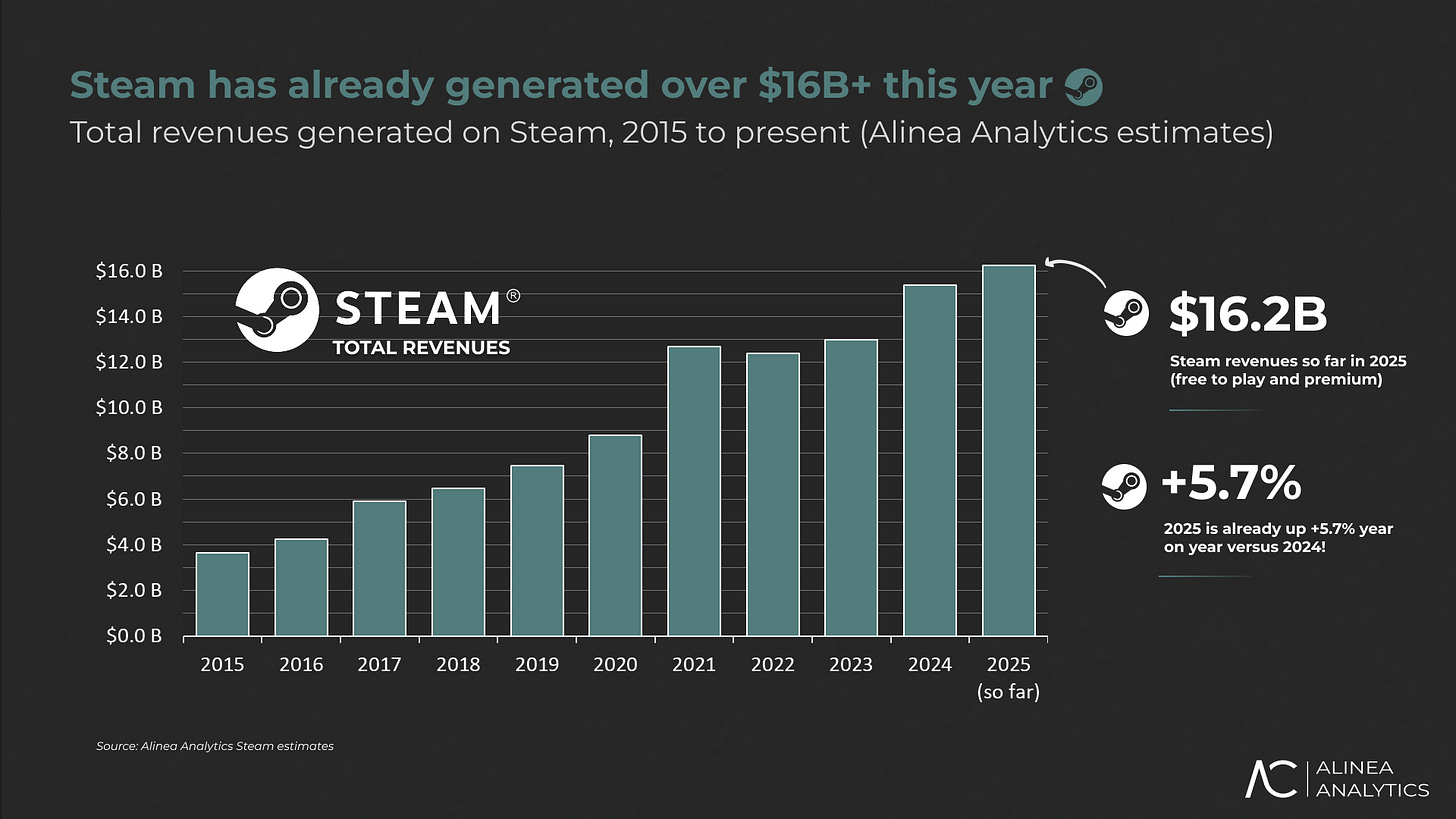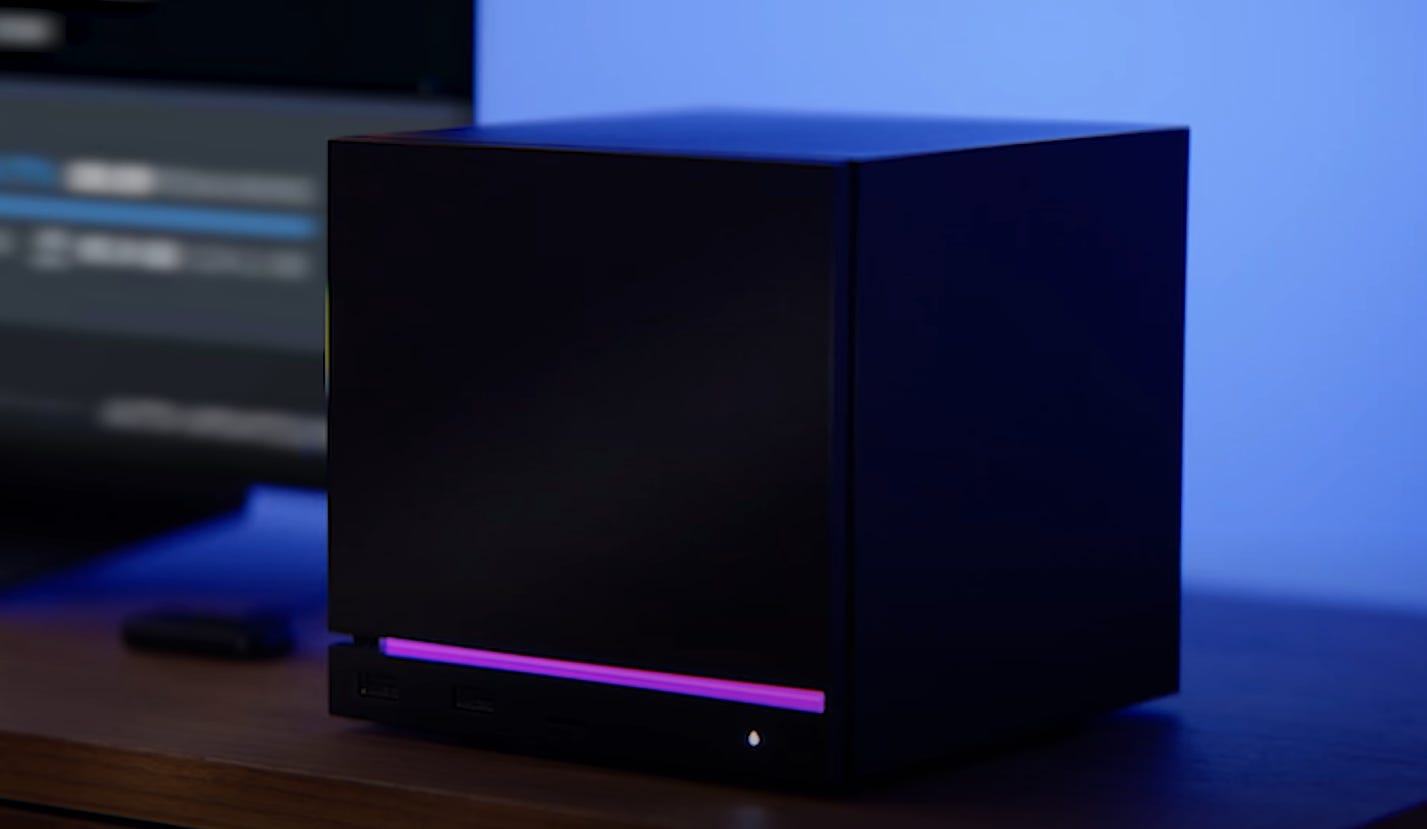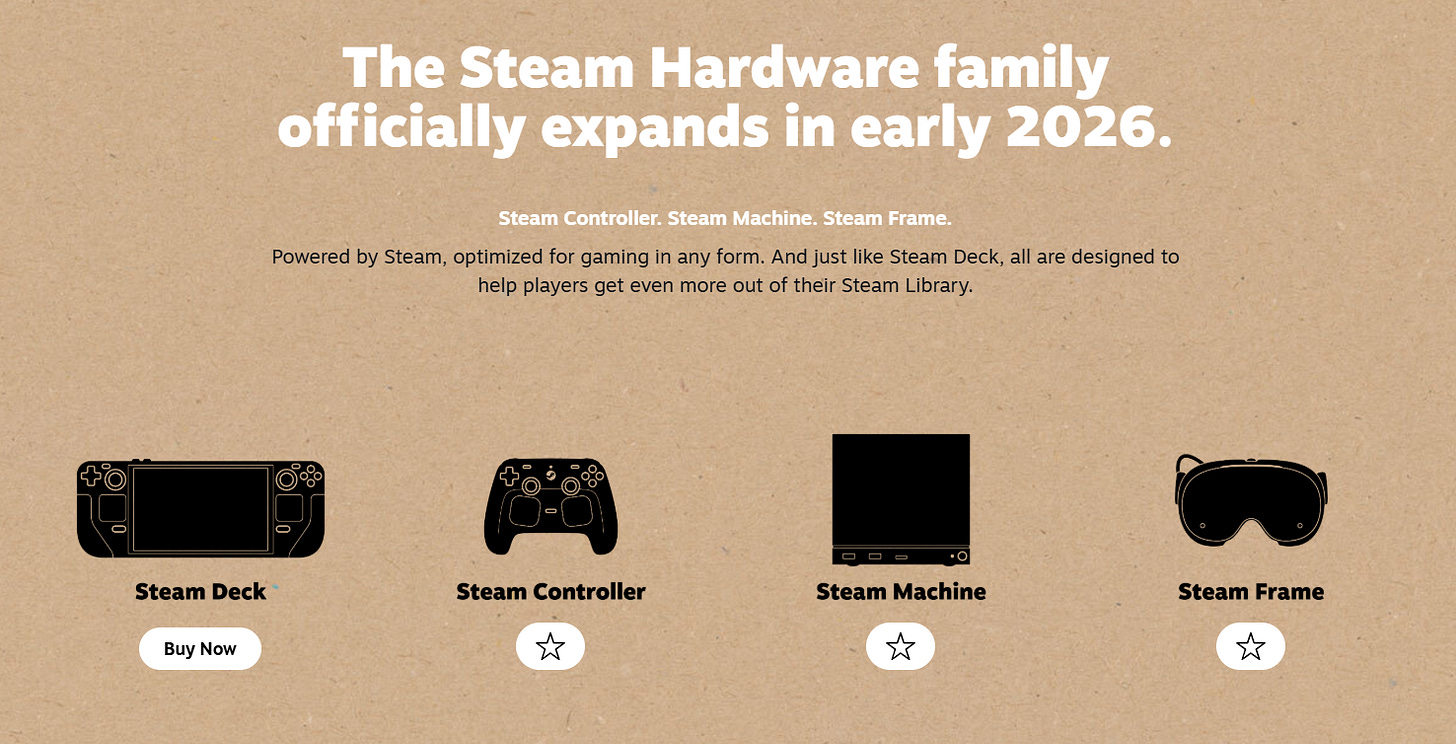Steam Machine cheat sheet: Valve’s bold, expected return to the living room
Valve has already made an estimated $4B+ on Steam this year. The Steam Machine is a strategy to boost its revenues and ecosystem further. Here's our take on Valve's upcoming console-like PC.
Valve announced its upcoming Steam Machine yesterday. Coming in 2026, the console-like PC has specs roughly equivalent to a PS5 (a little weaker). It’s the next logical step for Valve after its modest success with the Steam Deck.
The Steam Machine is not a mass-market device – not right now anyway. The Steam Machine:
Gives current Steam users more ways to play and pay on Steam, which worked wonders on the Steam Deck, boosting spending among those who picked it up.
Might convince some PC gaming-curious consumers to hop the fence. Valve’s jump into living-room hardware also further blurs the line between PC and console gaming.
Comes at the right time, a time of change, as PlayStation experiments with a portable device and perhaps its own PC launcher, when “everything is an Xbox,” and a new portable PC launches every 17 minutes.
The so-called console war is old news. We’re a ways off, but we’ve entered the next chapter, the ecosystem war.
Let’s get into it, starting with the first elephant in the room. This isn’t Valve’s first rodeo in the console-like PC space.
But things are different now
The original Steam Machines in 2015 stumbled (understatement of the year) due to fragmented hardware and a weak Linux gaming ecosystem. The gaming landscape – and Steam OS – has dramatically evolved since then.
With the Steam Deck, Valve built a thriving Linux-based ecosystem around SteamOS and its Proton compatibility layer, which now runs most Windows games seamlessly.
The modest success of the Steam Deck has given Valve the confidence to scale the concept up from handheld to home console, using a similar software foundation and a proven audience.
It was likely always the plan.
Valve is looking to make more money via software, not hardware
Valve’s strategy here isn’t concerned with profit margins on the Steam Machine hardware itself. Valve will probably take a hefty loss on the machine to expand its ecosystem, much like the Steam Deck, as well as console manufacturers, especially back in the day.
Every new Steam Machine sold represents another living-room anchor for the Steam storefront for (in-game) purchases. Valve’s already doing well on that front. As you can see below, we estimate that Steam has generated $16.2 billion this year so far:

Valve is making bank. For every game on its platform, Valve takes a 30% cut of sales under $10M, 25% on sales between $10M and $50M, and 20% on sales over $50M.
Taking this into account (and Valve’s 100% cuts of its own juggernauts CS2 and Dota 2), Valve itself has already made over $4B on its platform so far this year.
More places for consumers to play mean more places to pay. That’s what Valve is betting on, but it also wants some new Steam users. This all begs the question…
Who is the Steam Machine actually for?
Valve says that around 20% of Steam Deck users – that’s a few million – connect their device to a dock and play on TV. There’s a clear appetite for a couch-friendly PC gaming experience.
The use case is there, but the Steam Deck is a few years old now and is showing its age. Valve says its upcoming machine is six times more powerful.
So partially, the Steam Machine is for current Steam users. It’s an attractive second device for PC gamers who want a living-room gaming setup without building a full rig or investing in another ecosystem.
While a major part of the target audience is current Steam players, particularly for the first 2026 iteration, the Steam Machine also fits Valve’s mission to make PC gaming more accessible and flexible. Versus traditional gaming PCs, there’s no tinkering, fewer cables, and no drivers. Best-ish of both worlds.
So obviously, the Steam Machine is not solely for hardcore PC players but also for curious console players who want the freedom and affordability of PC gaming without the complexity.
The timing here is perfect, as Xbox seems to be abandoning traditional console hardware to become an ecosystem (more on that later), following on from mismanagement during the Xbox One era and Xbox pivoting to subscriptions out of necessity.
For younger consumers, the Steam Machine could serve as an on-ramp to PC gaming, bridging the gap between consoles and the open PC ecosystem. Streamer partnerships could help there.
Pricing will be critical – I reckon Steam will keep things low
Building a PC is bloody expensive. Seriously, I’m in the process of upgrading my rig, and I can’t believe what’s going on with memory prices. I digress.
There are also so many Steam players who still use older components. Plenty are in the market to upgrade to a mid-range machine, but can’t afford it. The Steam Machine could be the answer – if the price is right.
On that note, Valve also needs to set a price that trumps current-generation consoles while effectively marketing its use cases over traditional consoles (more on that in a bit). This is a no-brainer for getting meaningful traction among PC-curious gamers – not just PC enthusiasts.
If the Steam Machine launches above $500, it risks being perceived as an expensive niche PC (like the rumoured next-generation Xbox) rather than an accessible living-room gaming option.
The sweet spot would be $400 with a controller. This would really send a message, as console manufacturers have been raising their prices. A digital PS5 costs $499, while the Xbox Series X Digital is $599.
There are two different Steam Machine SKUs – a 512MB edition and a 2TB one. A $400-$450 floor price is feasible.
The Steam Machine has unique value propositions versus consoles
From a feature standpoint, the Steam Machine has compelling benefits over consoles:
Free online play: While PlayStation and Xbox don’t require subscriptions to play free-to-play games online, you need PS Plus Essential or Game Pass Core to play paid games like Black Ops 7, FC 26, and ARC Raiders. Steam doesn’t require a subscription for online play.
Steam sales and events: All those Steam sales blow the console sales out of the water, which is great for budget-minded gamers.
The flexibility of PC: The Steam Machine, despite having a console-like wrapping, also has the flexibility of a PC (if users want it). That means mods, access to other storefronts and apps (like emulators), functionality with more third-party peripherals, and more openness generally
More robust library: Steam is also the de-facto home of indies. Console-only players have missed out on indie phenomena like PEAK, Schedule I, and R.E.P.O. Valve’s own franchises like Counter-Strike 2, Dota 2, and Deadlock are also available. Steam sits at the crossroads of all major ecosystems (except Nintendo). It has practically every third-party release, gets Xbox games on day one, and PlayStation games eventually.
The launch of the Steam Machine could push PlayStation to rethink its approach to Steam. So far, Sony’s strategy has been to treat Steam as a secondary outlet, releasing games there months or years after their console debut, with only a few exceptions like the PvE Helldivers 2.
PlayStation might soon find that Steam isn’t just an auxiliary channel but also a rival ecosystem offering its own “console” with access to PlayStation’s own titles alongside competitors’ games – and without the hardware lock-in or online fees of PlayStation’s platform.

And there’s also all those Half-Life 3 rumours. Tinfoil hat time: Valve would make quite the splash by launching the Steam Machine in H1 next year – timed with a Half-Life 3 and Deadlock release. ‘‘Exclusives’’ sell ‘‘consoles’’.
But it’s not all sunshine and rainbows.
The Steam Machine also has some key challenges to overcome
One of Valve’s challenges remains software compatibility and performance consistency. While Proton has made massive strides, some anti-cheat-protected games like Destiny 2 and Battlefield 6 still don’t run.

Performance is another challenge. Even with upscaling tech, the 8GB of VRAM will limit high-end 4K performance. While we’re not there with FSR upscaling tech yet, the night is young. Valve may still deliver a smooth living room experience for most players.
Third-party manufacturers will also be able to use Steam OS in higher-powered set-top box devices, potentially offsetting that issue (while still netting Valve revenues via Steam.
What’s more, when the new PlayStation and Xbox machines come around (H1 2028, I reckon), Valve can iterate on its Steam Machines to bring its specs to parity.
“Just like with the Steam Deck, we’re really interested to see iteratewhat other companies do with the form factor. We have SteamOS running on third-party handhelds,’’ said Valve engineer Yazan Aldehayyat in a PC Gamer interview. ‘’If anything, we think that this form factor is even more apt for that.’’
In terms of more mainstream appeal, it’s worth noting that traditional consoles benefit from a strong retail presence. Consumers see them in stores, online, and bundled with games or accessories.
And that exposure reinforces their mainstream appeal among audiences who might not already be entrenched in PC gaming and enthusiast game communities.
Valve has historically lacked that retail footprint. This means Valve will need to again lean heavily on digital discoverability and marketing within its own ecosystem and via the media.
Eating Xbox’s lunch
The second elephant in the room is that Valve just got the jump on Xbox.
Microsoft’s gaming hardware strategy has already been drifting toward PC. Xbox has been directly funnelling its core console fans there with devices like the ROG Xbox Ally X (a portable ASUS PC with Xbox branding) and the next Xbox hardware (essentially a PC, rumour has it).
Worryingly for Xbox, Valve just built the bridge faster and might have offered an enticing console-like PC on-ramp for the disgruntled Xbox fans. And there are a lot of those (source: my DMs when I report anything marginally positive about Sony).
The difference is that Valve owns the dominant PC storefront, while the Microsoft store has floundered. Steam OS and Big Picture mode are also pretty seamless, while my time with the ROG Xbox Ally X suggests Windows still has a long way to go when it comes to playing nicely with a controller.
If successful, the Steam Machine could eat into Xbox’s core proposition: console-like simplicity backed by PC-like openness.
Players can install Windows or any other operating system they like on the Steam Machine, effectively turning it into a fully customisable gaming PC.
That means access not just to Steam, but to the Epic Games Store, GOG, the Xbox app, or even Game Pass – all within a small, living-room-friendly device.
This flexibility puts Valve ahead of Xbox in its own race toward a “PC-like” console future. However, Microsoft is among Steam’s top publishers by revenue, so they’ll benefit too.
Let the games begin
In the end, the new Steam Machine won’t outsell PlayStation or Nintendo hardware, but it doesn’t have to. Its real purpose is to strengthen the Steam ecosystem by offering players yet another way to engage.
If it manages to convince some new, younger, and console players to migrate to PC (or extend their gaming to PC), then it’s all the better for Valve.
Each new Valve device is a signal boost for the Steam platform, increasing touchpoints and user retention across contexts. For Valve, this is more about attention than hardware dominance.
If the price point is right, I could see Valve selling a couple of million Steam Machines next year. They’d need to stagger their supply well (they’ve learned a lot from the Steam Deck) and get the rollout right, though.
Either way, this is massive news and just the beginning. Valve’s move into living-room hardware is another huge step into gaming’s next big battle. And it comes at a time when PlayStation is working on a native portable and potentially a PC launcher, and ‘‘everything is an Xbox.’’
Move over console wars, the ecosystem wars are now in full swing.
Get a FREE trial of the Alinea platform
Want to get your hands on our data for yourself?
We’re offering a free trial of our platform for games companies. Just reach out here, or reply to this email, and we’ll set you up.
The last word
Reply to this email – or reach out here – if you have any feedback for the newsletter – or want to request a game for us to cover.
[Alinea Analytics boasts the most accurate PC and console estimates in the business. Game makers use our platform to understand their audience, keep an eye on the competition, monitor sales trends, and spot new opportunities. We equip game studios and financial institutions with accurate data and the confidence to make smarter, data-driven decisions. Want to talk about all things games market data? We’d love to chat!]







